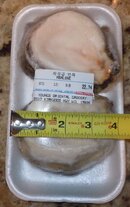- Messages
- 7,659
- Reaction score
- 4,720
- # of dives
- 200 - 499
ROFL!!!... Got the abalone, let me know when the moose arrives!!
Don't mess, the family has roots in Calais, ME. It could happen...
Welcome to ScubaBoard, the world's largest scuba diving community. Registration is not required to read the forums, but we encourage you to join. Joining has its benefits and enables you to participate in the discussions.
Benefits of registering include
ROFL!!!... Got the abalone, let me know when the moose arrives!!
Finnbiff or Reindeer Stew - My Little Norway works with moose or deer too.if some one gave me a Moose I would also appreciate a certain amount of direction in cooking.
See pic. They appear to have been forcefully pressed before freezing to make them look bigger. They are very "dished in" on top and bottom.Where did these abalone come from and how big ...//... The meats from a 4" abalone are about 3" in diameter. ...
You are most welcome and Thank you!We are very sensitive about our resource and fiercly protect it.
Thank you.

Thanks for attaching the pic.Eric,
Thanks for adding that information. See pic. They appear to have been forcefully pressed before freezing to make them look bigger. They are very "dished in" on top and bottom.
You are most welcome and Thank you!
I am now aware of this. If you have doubts, I'll save a sliver of each. I'm certain that a university/governmental agency knows the exact genotype of your inhabitants.
I am also very sensitive to poaching as we have an acute problem with it here too: Maine fishing crew hauls in a whale of a lobster - The Portland Press Herald / Maine Sunday Telegram
Lobsters just keep growing until something takes them out. Surprisingly and unfortunately for them, they don't get tougher or less tasty with age, just bigger and more desirable.
So you can imagine the pressure on them.
View attachment 384696
I'm only going on our local reds - I'd love to hear how these turn out.
I'm interested in your cleaning and polishing secrets, as well. I've had good luck cleaning the outside of the shell with muriatic acid and some picking and scrubbing, but have not figured out a practical way to protect the nacre during that process. I've tried wax, oil, and petroleum jelly, but while the wax gave good protection, it was difficult to clean off, and really time consuming. The oil and jelly were notably imperfect protecting against the acid. Polishing the shell insides afterwards helped a bit, but then cleaning the polishing compound out of the pores proved near impossible. You can probably tell I cast about with various approaches, but never really felt I'd hit on a good one. I'd love to hear your suggestions.
/QUOTE]
~~~~~~~~~~~~~~~~~~~~~~~~~~~~~~~~~~~~~~~~~~~~~~~~~~~~~~~~~~~~
Re Inside of the shell--Protection
WEAR EYE PROTECTION ! A DIVE MASK WORKS GREAT!!
1) Lay shell with the insides facing up
2) Heat paraffin (aka paro wax) to melting point in pan
( I have a dedicated pan for this process- reuse often )
3) Coat insides of shell with the melted paraffin
4) Individually place inside of shell - the coated side facing up in large stew pot
5) Bring temperature up to a simmer DO NOT BOIL !!! the shell wall develop hair line cracks with boiling
6) The paraffin melts floats to top
6) Allow the water with the melted paraffin to cool - generally over night
7) Skim off solidified paraffin floating on top of the water- save and reuse
8) Retrieve abalone shells from the bottom of the pan
9) Remove the paraffin (if any ) from shell with warm water and soap
RE Coating inside and out side of the shell
If is a record 11-12 inch red abalone specimen
Liberally spray with women's hair spray -- it is water soluble and can be washed off for cleaning and re sprayed
( I have a pump bottle of 99 cent store spray that has lasted for years)
This will insure its conchlological value to a future collector
If for home display many often coat with a clear "plastic" coating --
Its long term effect on the shell and the luster has yet to be determined
This destroys its conchological value to a collector
I NEVER COAT ANY SHELL ! ( And I have many shells from all over the world).
~~~~~~~~~~~~~~~~~~~~~~~~~~~~~~~~~~~~~~~~~~~~~~~~~~~~~~~
HAVE YOU EVER ATTEMTED TO USE A GRINFER ON THE OUT SIDE ?
BE VERY CAREFUL -- HAVE MUCHO VENTALATION
SHELL DUST IS VERY CAUSTIC TO THE RESPIRATORY SYSTEM
The above and several other techniques for marine life preservation appeared in several long out of print books, two that come immediately to mind are "Diving safe and simple" by Resic in the 1960s, "Diving west " by Fullerton (first edition) in the early 1970s and the article in the magazine "Discover Diving" 25 years ago.
Since I have been lecturing and writing about cleaning a polishing Abalone shells and how to preserve marine life for well over 50 years I guess am the unheralded father of Shell cleaning --put that with a dollar and a cup of coffee still will cost a dollar.
Hope this is of assistance ...If you have questions please post --
SDM
It is daylight - my little dog Max is at my feet and we are off to the beach
